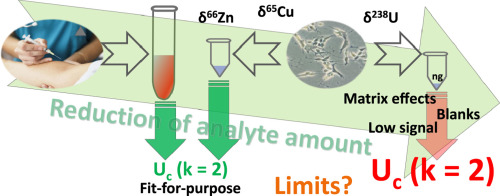Talanta ( IF 6.1 ) Pub Date : 2017-10-23 , DOI: 10.1016/j.talanta.2017.10.046 Eduardo Paredes , Emilie Avazeri , Véronique Malard , Claude Vidaud , Richard Ortega , Anthony Nonell , Hélène Isnard , Frédéric Chartier , Carole Bresson

|
The monitoring of isotopic fractionations in in vitro cultured human cell samples is a very promising and under-exploited tool to help identify the metabolic processes leading to disease-induced isotopic fractionations or decipher metabolic pathways of toxic metals in these samples. One of the limitations is that the analytes are often present at small amounts, ranging from tens to hundreds of ng, thus making challenging low-uncertainty isotope ratio determinations. Here we present a new procedure for U, Cu and Zn purification and isotope ratio determinations in cultured human neuron-like cells exposed to natural U. A thorough study of the influence of the limiting factors impacting the uncertainty of δ238U, δ66Zn and δ65Cu is also carried out. These factors include the signal intensity, which determines the within-day measurement reproducibility, the procedural blank correction and the matrix effects, which determine the accuracy of the mass bias correction models. Given the small Cu and U amounts in the cell samples, 15–30 and 20 ng respectively, a highly efficient sample introduction system was employed in order to improve the analyte transport to the plasma and, hence, the signal intensity. With this device, the procedural blanks became the main uncertainty source of δ238U and δ65Cu values, accounting over 65% of the overall uncertainty. The matrix effects gave rise to inaccuracies in the mass bias correction models for samples finally dissolved in the minimal volumes required for the analysis, 100–150 µL, leading to biases for U and Cu. We will show how these biases can be cancelled out by dissolving the samples in volumes of at least 300 µL for Cu and 450 µL for U. Using our procedure, expanded uncertainties (k = 2) of around 0.35‰ for δ238U and 0.15‰ for δ66Zn and δ65Cu could be obtained. The analytical approach presented in this work is also applicable to other biological microsamples and can be extended to other elements and applications.
中文翻译:

一种用于测定人类细胞中纳克水平的U,Cu和Zn的高精度同位素比的新方法:限制因素是什么?
体外培养的人类细胞样品中同位素分馏的监测是非常有前途且开发不足的工具,可帮助识别导致疾病诱导的同位素分馏或这些样品中有毒金属的代谢途径的代谢过程。局限性之一是分析物经常以少量存在,范围从几十到几百ng,因此很难确定低不确定度的同位素比。这里,我们提出对U,Cu和Zn的纯化和同位素比确定一个新的程序在体外培养的人神经元样暴露于影响的δ的不确定性的限制因素的影响的自然U.彻底研究细胞238U,δ 66Zn和δ 65铜也进行了。这些因素包括确定日内测量重现性的信号强度,程序空白校正和基质效应,这些效应确定质量偏差校正模型的准确性。考虑到细胞样品中的铜和铀含量较低,分别为15–30和20 ng,因此采用了高效的样品引入系统,以改善分析物向血浆的转运,从而改善信号强度。使用该装置,程序坯料成为δ238U和δ65Cu的主要不确定性来源值,占总体不确定性的65%以上。对于最终溶解在分析所需的最小体积(100-150 µL)中的样品,基质效应会导致质量偏差校正模型的误差,从而导致U和Cu的偏差。我们将展示如何通过将样品溶解成至少300 µL的Cu和450 µL的U来消除这些偏差。使用我们的程序,δ238U和0.15‰的扩展不确定度(k = 2)约为0.35‰。对于δ 66Zn和δ 65Cu可以得到的。这项工作中介绍的分析方法也适用于其他生物微量样品,并且可以扩展到其他元素和应用。


























 京公网安备 11010802027423号
京公网安备 11010802027423号